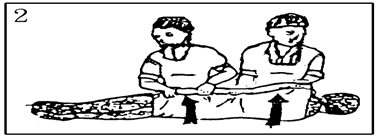Post-spine surgery care instructions
Date:2024-12-03Pingtung Branch of Kaohsiung Armed Forces General Hospital

Post-spine surgery care instructions
1、After surgery, return to the ward. Due to general anesthesia, fasting is required for 4-6 hours. When starting to eat, begin with a small amount of water. If there is no nausea or vomiting, you can proceed with solid food.
2、Keep the surgical wound clean and dry. If there is any seepage of blood or moisture, notify the medical staff for proper handling to prevent infection.
3、If there is a drainage tube at the surgical site, ensure it remains unobstructed. Avoid pulling, twisting, or pressing the tube. Be cautious when turning to prevent displacement.
4、For spine surgery patients, it is recommended to sleep on a firmer mattress. The mattress should allow a 3 cm sink in the lower back when lying down. When lying on your back, place pillows under your head and knees to relax the back muscles. When lying on your side, keep your knees slightly bent and place a pillow between your legs to avoid excessive knee bending, which reduces pressure on the lumbar spine. Place another pillow under your upper arm to prevent shoulder drooping. Avoid sleeping on your stomach as it increases pressure on the lower back.
5、Turn in bed at least every 2 hours to avoid prolonged pressure on the back. When turning, first adjust the bed to level and keep the spine aligned, avoiding twisting the back.
Method: The person helping to turn should stand on the side the patient is turning to. One hand should be placed on the shoulder, and the other on the hip, keeping the spine straight while completing the turn (as shown in the illustration). You can also use a turning sheet to assist and reduce discomfort.

6、During bed rest, bowel movements may slow down. Increase intake of high-fiber vegetables and fruits, such as celery, Chinese kale, tangerines, oranges, and tomatoes. If there are no fluid restrictions, drink at least 2500 cc of water daily to prevent constipation. Follow the instructions of medical staff regarding physical activity.
7、Sit up or get out of bed only with the doctor’s approval. When getting up, first roll to the side before sitting up; avoid sitting up directly from the bed. Keep the back straight and avoid slouching in the chair. Gradually start standing and walking based on your physical ability, avoiding prolonged standing. If standing for an extended period, alternate feet on a footstool.
8、When walking for the first time, wear stable, non-slip shoes, and avoid slippers or high heels to reduce the risk of slipping.
9、After spine surgery, wear a neck brace or back brace for 3-6 months (to ensure bone healing and reduce the chance of recurrence), and it should only be removed with the approval of the attending physician.
10、Wear the neck brace or back brace when getting out of bed, except when showering, but always maintain a straight spine, avoiding twisting or bending the spine.
11、After returning home, it is recommended to change the dressing daily. If there is excessive sweating, bleeding, or the wound gets wet, replace the dressing immediately. If there is any discharge, inflammation, unusual pain, worsening pain, numbness, coldness, limping, or inability to lift the leg, contact the medical staff and return for a check-up.
12、Perform deep breathing after the surgery: Inhale deeply through the nose and exhale slowly through the mouth, 10 times per session, 2-3 times a day, to expand the lungs and prevent pneumonia.
13、During bed rest, move your limbs. Perform stretching and bending exercises for the joints (upper limbs, hips, knees, and ankles). This helps improve venous return to the heart. Do at least 5 sessions of movement each day.
14、When wearing shoes or picking up something, avoid bending over. Instead, squat down to pick it up.
15、Avoid twisting to reach for items, and refrain from lifting heavy objects or engaging in intense physical activity shortly after surgery.
16、The frequency of exercise should be based on personal condition, and avoid overexertion. If you feel discomfort or pain during activities, inform the physical therapist for adjustments.